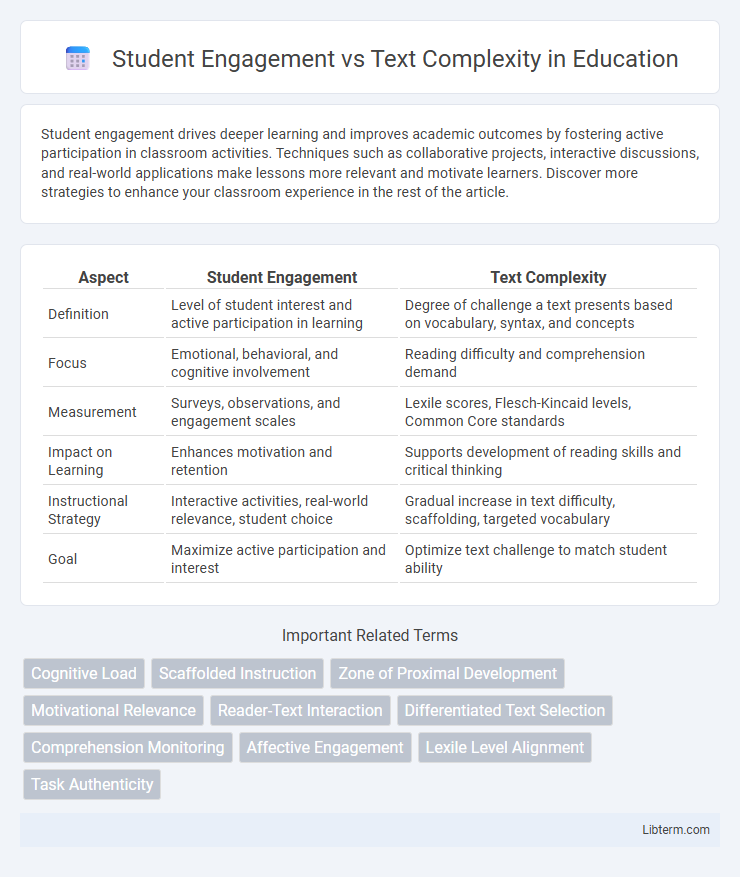Student engagement drives deeper learning and improves academic outcomes by fostering active participation in classroom activities. Techniques such as collaborative projects, interactive discussions, and real-world applications make lessons more relevant and motivate learners. Discover more strategies to enhance your classroom experience in the rest of the article.
Table of Comparison
| Aspect | Student Engagement | Text Complexity |
|---|---|---|
| Definition | Level of student interest and active participation in learning | Degree of challenge a text presents based on vocabulary, syntax, and concepts |
| Focus | Emotional, behavioral, and cognitive involvement | Reading difficulty and comprehension demand |
| Measurement | Surveys, observations, and engagement scales | Lexile scores, Flesch-Kincaid levels, Common Core standards |
| Impact on Learning | Enhances motivation and retention | Supports development of reading skills and critical thinking |
| Instructional Strategy | Interactive activities, real-world relevance, student choice | Gradual increase in text difficulty, scaffolding, targeted vocabulary |
| Goal | Maximize active participation and interest | Optimize text challenge to match student ability |
Understanding Student Engagement
Understanding student engagement involves recognizing its key dimensions: behavioral, emotional, and cognitive engagement, which influence how students interact with text complexity. Higher text complexity demands increased cognitive strategies, making engagement critical for comprehension and retention. Effective engagement strategies align instructional materials with students' interests and skill levels to enhance motivation and deepen understanding.
Defining Text Complexity
Text complexity is defined by quantitative measures such as readability scores, qualitative factors including text structure and language clarity, and reader-task considerations that assess a student's purpose and motivation. High text complexity challenges vocabulary, sentence length, and abstract concepts, impacting how deeply students engage with the material. Understanding and aligning text complexity with student abilities is essential for maximizing engagement and promoting comprehension growth.
The Relationship Between Engagement and Complexity
Student engagement tends to decrease as text complexity increases, especially when reading materials exceed their comprehension levels. High text complexity demands greater cognitive effort, often leading to frustration and disengagement among students. Tailoring texts to balance challenge with accessibility enhances engagement and promotes deeper learning outcomes.
Why Text Complexity Matters in Learning
Text complexity directly impacts student engagement by challenging their comprehension skills and promoting critical thinking. Appropriate text complexity fosters cognitive development and motivates learners to interact deeply with the material, enhancing retention and understanding. Aligning text difficulty with student proficiency levels ensures optimal learning outcomes and prevents frustration or disengagement.
Strategies to Enhance Student Engagement
Strategies to enhance student engagement in relation to text complexity include incorporating interactive reading activities, such as guided reading sessions and collaborative discussions, to help students navigate challenging texts more effectively. Utilizing differentiated instruction by selecting texts that match students' reading levels and interests can boost motivation and comprehension. Implementing technology tools like annotation apps and interactive e-books supports active reading and deeper engagement with complex materials.
Challenges of High Text Complexity
High text complexity presents significant challenges to student engagement by overwhelming learners with dense vocabulary, intricate sentence structures, and abstract concepts that impede comprehension. Struggling to decode and interpret difficult texts often leads to frustration and disengagement, reducing motivation to participate actively in reading tasks. Tailored scaffolding and differentiated instruction become essential to bridge the gap between student abilities and rigorous texts, fostering sustained engagement and deeper learning.
Balancing Engagement and Rigor
Balancing student engagement with text complexity requires selecting materials that challenge learners while maintaining their interest through relevant themes and accessible vocabulary. Effective strategies include differentiating texts to match diverse reading levels and incorporating interactive activities that connect content to real-world experiences. Research shows that when students are motivated by meaningful texts, comprehension and critical thinking skills improve despite high cognitive demands.
Adapting Instruction for Diverse Learners
Adapting instruction for diverse learners requires balancing student engagement with appropriate text complexity to support comprehension and motivation. Differentiated strategies such as scaffolding, multimodal resources, and personalized reading materials help address varying literacy levels and cultural backgrounds. Effective adaptation enhances accessibility, promotes deeper understanding, and fosters sustained engagement across heterogeneous classrooms.
Measuring Success: Engagement vs. Achievement
Measuring success in education requires analyzing both student engagement and text complexity, where high engagement often correlates with improved achievement outcomes. Metrics such as time-on-task, participation rates, and self-reported interest provide data on engagement, while standardized test scores and comprehension assessments gauge achievement relative to text difficulty. Balancing text complexity with strategies that foster active engagement enhances both cognitive challenge and academic success.
Best Practices for Selecting Appropriate Texts
Selecting texts that align with students' reading levels enhances comprehension and maintains engagement by providing an optimal challenge. Utilizing texts with varied genres, themes, and cultural relevance fosters motivation and connects learning to students' experiences. Incorporating scaffolded support, such as guided reading questions and vocabulary previews, further bridges gaps between text complexity and student ability, encouraging deeper interaction with the material.
Student Engagement Infographic

 libterm.com
libterm.com